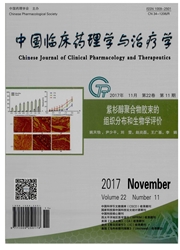

 中文摘要:
中文摘要:
目的:探讨接受可吸入性皮质激素治疗-年以上的哮喘患者的骨质减少和骨质疏松的发病状况以及哮喘患者骨质减少和骨质疏松的危险因素。方法:自2007年8月到2011年7月,接受吸入性皮质激素治疗且治疗时间-年以上的哮喘患者为研究组,未接受吸入性皮质激素治疗的哮喘患者为对照组,哮喘患者年龄均在18岁以上。骨密度检测采用DEXA检测。骨质减少和骨质疏松采用WHOT—score评分。骨代谢指标包括血骨钙素以及碱性磷酸酶等,检测方法采用放免法进行。结果:研究对象共143名,其中研究组69例,对照组74例。研究组与对照组患者的血骨钙素水平分别为(3.8±2.4)、(2.7±1.4)μg/L,两组间无统计学差异(P=0.57)。两组患者的血碱性磷酸酶水平分别为(126±68)、(119±66)IU/L,两组间无统计学差异(P=0.37)。研究组和对照组患者的脊柱T—score评分均数分别为-0.72和-0.57(P=0.98);股骨T—score评分均数分别为-0.60和-0.80(P=0.474);髋骨T—score评分均数分别为0.19和0.06(P=0.275)。脊柱、股骨和髋骨T—score评分与年龄呈显著负相关,而与体重指数呈显著正相关。结论:哮喘患者骨质减少和骨质疏松危险因素是高龄和低体重指数,吸入皮质激素无累积效应。与对照组患者相比,吸入皮质激素治疗哮喘的患者没有其他的骨质减少和骨质疏松的危险因素。
 英文摘要:
英文摘要:
To explore the prevence of osteopenia and osteoporosis and to determine the risk factors in ashmatic patients receiving inhaled corticosteroids (ICS)for more than one year. METHODS: The study was conducted from Au gust 2007 to July 2011. Asthmatic patients who had been on ICS for at least one year (test group) and a control group of snbiects not on ICS were included and all the included patients were more than 18 years. BMD was measured using DEXA (dual energy X-ray absorptiometry) scan. Osteopenia and osteoporosis was evaluated by the WHO classification of T-score. The lev els of serum bone ga protein(BGP)and alkaline phosphatase (AKP) were detected by radio im munoassay. RESULTS:All the subjects were 149 patients. Test group who had been on ICS were 69 subjects and control group were 74 subjects. The levels of BGP in test group and control were (3.8±2.4), (2,7±1.4) /,g/L, respectively, and there was no significant difference between two groups. The levels of AKP were (126 ± 68),(119±66) U/L in test group and control, respectively and they also had not significant difference. T-score of the spine, femur, and hip of the asthmatics vs the control subjects were mean, --0.72 vs --0.57(P=0.98) mean, -- 0.60 vs --0.80(P=0. 474) and mean, 0.19 vs 0.06 (P〈0. 275); respectively. T-scores of the spine, femur, and hip showed significantly negative correlation with age and significantly posi tive correlation with body mass index (BMI). CONCLUSION: The risk factors of osteopenia and osteoporosis are older age and lower body mass index (BMI), not the cumulatively inhaled corticosteroids in asthmatic patients. There are not other risk factors of osteopenia and osteoporosis inpatients inhaled corticosteroids when compared with control.
 同期刊论文项目
同期刊论文项目
 同项目期刊论文
同项目期刊论文
 期刊信息
期刊信息
